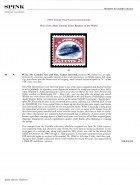⇚ Position 90 - 2009-06-18 Transaction Summary
Purchase Date:
2009-06-18
How Purchased:
Auction
Where Purchased:
Spink Shreves
Auction No.:
114
Lot No.:
46
Sound/Fault:
Sound
Catalogue Value:
$ 0
Realized:
$ 195,500
Seller:
Buyer:
Anonymous
Description
#C3a, 24c Carmine rose and blue, Center Inverted, position 90, natural s.e. at right,
attractively centered, especially intense colors and impressions on bright paper, full clean
o.g. that shows just the barest trace of hinging, small natural inclusion speck in "4" of left
"24", fine-very fine.
The 1918 Twenty Four Cent Inverted Jenny is one of the most recognized and desired rarities in all of philately. Its legendary status began the moment the stamp was issued in May, 1918, when William T Robey purchased an entire error sheet of 100 at the New York Avenue Post Office window in Washington D.C. -May 14th -just one day after the stamp was issued. Within one week Robey sold the sheet for $15,000.00 to the well-known Philadelphia stamp dealer Eugene Klein (an impressive return on his initial $24.00 investment). Shortly thereafter Mr. Klein sold the sheet to the renowned, yet eccentric collector, Col. Edward H.R. Green for $20,000.00. Col. Green asked Klein to break up the sheet for· him into singles and blocks, then instructed him to sell all but the few key position blocks. What is puzzling is how, given the immediate attention created by a spectacular new error, so many of the stamps from the sheet have been poorly handled and stored over the years. In fact, there are at least six examples whose whereabouts are unknown and presumably lost to philately. A great many of the known copies have varying degrees of faults and some even have lost all of their original gum. Improper hinging has caused a significant number of the faults, often thinning or creasing the stamps.
The example from the Cunliffe collection, which he acquired in a June 30, 1964 auction, is an especially fresh and attractive copy of this, the most famous stamp in philately. It was once part of a vertical pair, along with position 100, which was sold in the Green Sale XXIII in October 15, 1945 (Hugh C. Barr auction). It was later separated from position 100 and sold again at auction in November 20, 1956 by Sylvester Colby. And then ending up in the Cunliffe collection where it has resided for nearly 45 years. Accompanied by a 1966 PF certificate.
The 1918 Twenty Four Cent Inverted Jenny is one of the most recognized and desired rarities in all of philately. Its legendary status began the moment the stamp was issued in May, 1918, when William T Robey purchased an entire error sheet of 100 at the New York Avenue Post Office window in Washington D.C. -May 14th -just one day after the stamp was issued. Within one week Robey sold the sheet for $15,000.00 to the well-known Philadelphia stamp dealer Eugene Klein (an impressive return on his initial $24.00 investment). Shortly thereafter Mr. Klein sold the sheet to the renowned, yet eccentric collector, Col. Edward H.R. Green for $20,000.00. Col. Green asked Klein to break up the sheet for· him into singles and blocks, then instructed him to sell all but the few key position blocks. What is puzzling is how, given the immediate attention created by a spectacular new error, so many of the stamps from the sheet have been poorly handled and stored over the years. In fact, there are at least six examples whose whereabouts are unknown and presumably lost to philately. A great many of the known copies have varying degrees of faults and some even have lost all of their original gum. Improper hinging has caused a significant number of the faults, often thinning or creasing the stamps.
The example from the Cunliffe collection, which he acquired in a June 30, 1964 auction, is an especially fresh and attractive copy of this, the most famous stamp in philately. It was once part of a vertical pair, along with position 100, which was sold in the Green Sale XXIII in October 15, 1945 (Hugh C. Barr auction). It was later separated from position 100 and sold again at auction in November 20, 1956 by Sylvester Colby. And then ending up in the Cunliffe collection where it has resided for nearly 45 years. Accompanied by a 1966 PF certificate.

